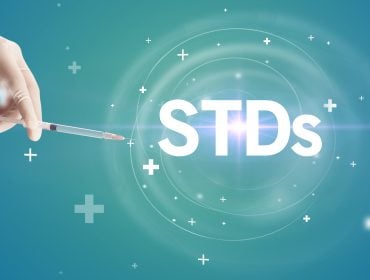Chances of Catching an STD
Although many people think that STDs are only spread via intercourse, they actually can be contracted many ways. You do not have to have sex (whether vaginal, anal or oral) to contract or transmit an STD. Because these infections and diseases are caused by separate bacteria or viruses, you can have more than one at the same time. You can also become re-infected with bacterial STDs after treatment if exposed to them again.
You can get STDs the following ways:
Various types of Sex
Vaginal intercourse – Vaginal intercourse is sex between a man and a woman, during which the penis is inserted into the vagina. Chlamydia, gonorrhea, syphilis, HIV, HPV, genital herpes, hepatitis B and C, and trichomoniasis can all be spread via vaginal intercourse.
Anal sex – STDs that can spread via anal sex are chlamydia, gonorrhea, syphilis, HIV, HPV, hepatitis B and hepatitis C.
Oral sex – While it is often more difficult to contract an STD via oral sex –whether fellatio, cunnilingus or analingus– it is very possible to get chlamydia, gonorrhea, syphilis, oral herpes, genital herpes, HPV, and/or hepatitis B this way. Hepatitis A contracted from analingus is considered an STD.
Contracting an STD through Blood-Exchange
Intravenous needles – Sharing needles used for injecting drugs can spread HIV, hepatitis B and hepatitis C. Sharing straws or money to snort drugs like cocaine can also spread STDs. Both of these reasons are believed to be a major cause in the high rate of hepatitis C among baby boomers. Hospital workers and first responders need to be extra cautious when dealing with used hypodermic needles to avoid accidentally sticking themselves.
Blood transfusions & solid organ transplants – Before 1985 there was no way to screen blood donations or organs for HIV, and hepatitis C was not screened for before 1992. Even now, blood transfusions still carry a risk of infecting the recipient with HIV.
Tattoo or piercing equipment that is not properly sterilized can transmit HIV, hepatitis B and hepatitis C.
Open sores, wounds or cuts can allow infected blood to enter the body. Those giving medical aid need to be sure to have their own sores or wounds completely covered as to not risk getting STD infected blood mixed with there own. HIV, hepatitis B and hepatitis C can all be contracted this way.
Healthcare providers or first responders who come in contact with blood or used hypodermic needles need to be extra cautious to avoid blood-borne STDs and diseases.
STDs with Pregnancy and Childbirth:
Mothers with an STD or STDs can transmit them to their fetus or baby during pregnancy or childbirth. Genital herpes, gonorrhea, chlamydia, syphilis, HIV and hepatitis B and C can all be transmitted to babies during delivery. HPV can cause genital warts, and if an enlarged wart blocks the birth canal, the baby will have to be delivered via cesarean section. These infections are especially dangerous to newborns and can even cause blindness or death, read more here.
Breastfeeding:
HIV can be transmitted from mother to baby during breastfeeding if the mother is HIV-positive.
Skin-To-Skin Contact
Chlamydia, gonorrhea, and herpes can infect eye tissue if an individual has touched parts of the body that contain traces of these diseases, and then their eye(s).
Herpes and HPV can be transmitted from intimate skin-to-skin contact.
Trichomoniasis can be contracted from hand-to-genital contact.
STDs Through Infected Objects (Indirect Contact):
Sex toys that were not properly washed can be the source of trichomoniasis, gonorrhea, chlamydia, syphilis and herpes. If any blood is on the sex toy, HIV and hepatitis B and C can be contracted from it.
Bedding, towels, etc., can host trichomoniasis or crabs (pubic lice) for awhile outside the body and spread infection.
High-Risk Activities for Contracting STDs:
- Unprotected vaginal or anal sex
- Oral sex without a dental/sex dam
- Sharing needles and drug equipment
- Getting piercings or tattoos from improperly sterilized equipment
- Having sex while under the influence of drugs or alcohol can make you more likely to participate in risky behavior, like unprotected sex or having sex with a stranger
- Having sex with an anonymous partner
- Having sex with more than one partner
- Having sex with a partner who has sex with others
Low-Risk Activities for Contracting STDs:
- Fondling, “dry humping,” and manual stimulation of each other
- Intimate skin-to-skin contact without intercourse
- Playing with sex toys
- Kissing, making-out
- Mutual Masturbation
- Having sex exclusively with one STD-free partner who only has sex with you
- Using condoms during sex — condoms do not cover everything, so these STDs can still be contracted: HPV, herpes or syphilis (if a syphilis sore/chancre is exposed and contact is made)
No-Risk Activities for Contracting STDs:
- Abstinence
- Masturbation
Activities That Help Avoid STDs:
- Get vaccinated for HPV, hepatitis A and hepatitis B before engaging in sexual activities
- Use a condom every time you have sex
- Get tested together for all STDs prior to engaging in sexual activity with a new partner
- Staying sober
- Not sharing sex toys
- Limiting your sexual partners
- Knowing your sexual partners prior to having sex with them
- Finding out if pre-exposure prophylaxis (PrEP) is a good option for you to prevent HIV infection if your partner is HIV-positive and following treatment adamantly
Individuals Who Are Most At-Risk For Contracting STDs:
- Men who have sex with men (MSM)
- Hepatitis C is more common in individuals born between 1945-1965
- Individuals who have been incarcerated
- Drug users (past or present)
- People with multiple partners
- People who do not use protection (condoms, dental/sex dams)
- Being between the ages of 13 and 25; young people are less educated about STDs, take more risks, and young women’s cervixes are still developing, which makes them more susceptible to certain STDs
- People who have an STD are more likely to contract another
Read Section 3 on Chlamydia and Chlamydia Testing.
Medically Reviewed by J. Frank Martin JR., MD on October 3, 2023
Secure and Confidential
STD testing services
The fastest results possbile - available in 1 to 2 days

Tagged
Categorized As
Author: Nick Corlis
Nick Corlis is a writer, marketer, and designer. He graduated from Texas State University in San Marcos, Texas, with a degree in Digital Communications. Nick is proud to be able to help eliminate the stigma of STD testing through his writing and is always trying to advocate the importance of your sexual health. Before STDcheck, his favorite way to develop his writing skills was by accepting various writing jobs in college and maintaining multiple blogs. Nick wears many hats here at STDcheck, but specifically enjoys writing accurate, well-researched content that is not only informative and relatable but sometimes also contains memes. When not writing, Nick likes to race cars and go-karts, eat Japanese food, and play games on his computer.




